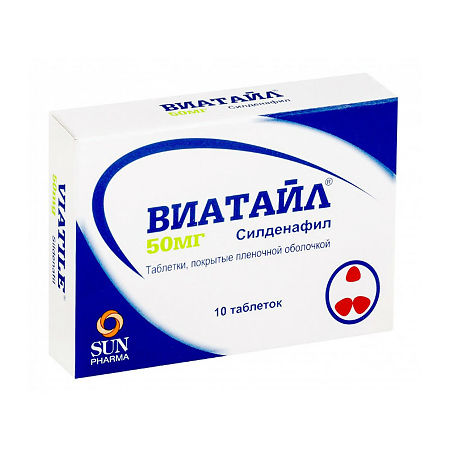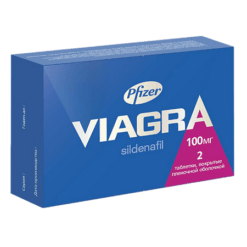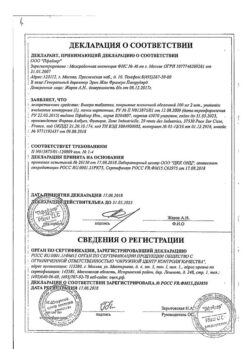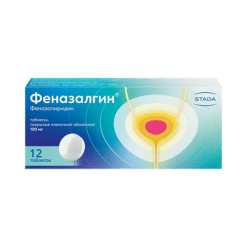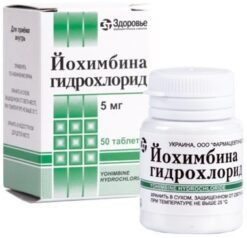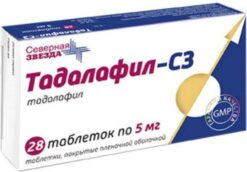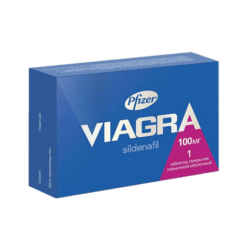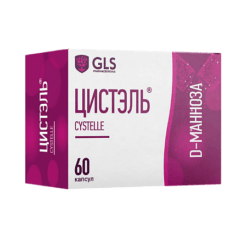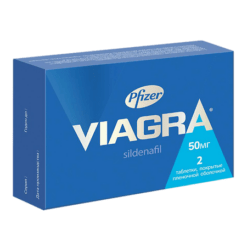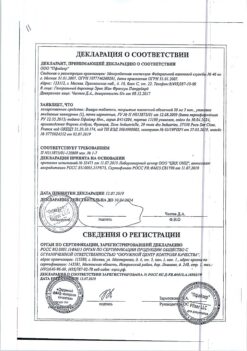No products in the cart.
Viatail 50 mg, 10 pcs.
€1.00
Out of stock
(E-mail when Stock is available)
Description
Sildenafil is a powerful selective inhibitor of cycloguanosine monophosphate (cGMP)-specific phosphodiesterase type 5 (FDE5). Realization of the physiological mechanism of erection is connected with release of nitric oxide (NO) in the cavernous body during sexual stimulation. This, in its turn, leads to increase of cGMP level, subsequent relaxation of smooth muscle tissue of the cavernous body and increase of blood flow. Sildenafil does not have a direct relaxing effect on the isolated human cavernous body, but it enhances the effect of NO via FDE5, which is responsible for the breakdown of cGMP.
Sildenafil is selective against FDE5 in vitro, its activity against FDE5 is superior to other known phosphodiesterase isoenzymes: FDE6, 10 times; FDE1, more than 80 times; FDE2, FDE4, FDE7-FDE11, more than 700 times. Sildenafil is 4,000 times more selective against FDE5 compared to FDE3, which is of critical importance because FDE3 is one of the key enzymes regulating myocardial contractility.
A prerequisite for the effectiveness of sildenafil is sexual stimulation.
The use of sildenafil in doses up to 100 mg did not result in clinically significant electrocardiogram (ECG) changes in healthy volunteers. The maximum decrease in systolic blood pressure after sildenafil 100 mg was 8.3 mmHg in the supine position, and in diastolic blood pressure, 5.3 mmHg. A more pronounced but also transient effect on BP was noted in patients taking nitrates. In sildenafil administration, exercise tolerance is significantly higher in patients with erectile dysfunction and stable angina pectoris taking antianginal drugs (except nitrates).
Sildenafil improves erection in men with erectile dysfunction and arterial hypertension taking more than two antihypertensive drugs. The incidence of adverse effects is comparable to that in other patient groups, as well as in those taking more than three antihypertensive drugs.
Some patients show mild and transient impairment in the ability to distinguish shades of color (blue/green) 1 h after taking sildenafil at a dose of 100 mg using the Farnsworth-Mansell 100 test. Two hours after taking the drug, these changes disappear. It is believed that color vision impairment is caused by inhibition of FDE6, which is involved in the process of light transmission in the retina. Sildenafil has no effect on visual acuity, contrast perception, the electroretinogram, intraocular pressure, or pupil diameter.
In patients with proven early-onset macular degeneration (n=9), sildenafil at a single dose of 100 mg was well tolerated with no significant visual changes.
The efficacy of sildenafil is defined as the ability to achieve and maintain an erection sufficient for satisfactory intercourse. A fixed dose improves erections in 62% (sildenafil 25 mg dose), 74% (sildenafil 50 mg dose), and 82% (sildenafil 100 mg dose) of cases. Analysis of the international erectile function index shows that in addition to improvement of erection with sildenafil treatment, the quality of orgasm, satisfaction of sexual intercourse and overall satisfaction are also improved.
According to generalized data, among the patients who reported improved erections with sildenafil treatment were 59% of diabetic patients, 43% of patients who underwent radical prostatectomy, and 83% of patients with spinal cord injuries.
Indications
Indications
– treatment of erectile dysfunction characterized by the inability to achieve or maintain an erection of the penis sufficient for satisfactory intercourse.
Sildenafil is effective only with sexual stimulation.
Active ingredient
Active ingredient
Composition
Composition
Red film-coated tablets, triangular in shape with rounded edges; engraved “S22” on one side and smooth on the other.
Associates:
Microcrystalline cellulose* – 168.76 mg,
calcium hydrophosphate anhydrous – 50 mg,
croscarmellose sodium – 6 mg,
magnesium stearate – 5 mg,
opadray red (06B 55000) – 9 mg.
Composition of Opadray Red (06B 55000):
Hypromellose 15 cP – 29.5%, Hypromellose 6 cP – 29.5%, crimson dye [Ponceau 4R] (E124) – 19.712%, macrogol 400 – 11%, titanium dioxide – 8.846%, iron oxide red dye – 0.824%, indigo carmine – 0.618%.
Interaction
Interaction
Influence of other drugs on the pharmacokinetics of sildenafil
The metabolism of sildenafil occurs mainly under the action of cytochrome CYP3A4 isoenzymes (main pathway) and CYP2C9, therefore inhibitors of these isoenzymes may decrease sildenafil clearance, and inducers, respectively, increase sildenafil clearance. There was noted a decrease in sildenafil clearance when concomitant use of inhibitors of CYP3A4 cytochrome isoenzyme (ketoconazole, erythromycin, cimetidine). Cimetidine (800 mg), a non-specific inhibitor of cytochrome CYP3A4 isoenzyme, when taken together with sildenafil (50 mg) increases sildenafil concentration in plasma by 56%. Simultaneous use of sildenafil 100 mg together with erythromycin (250 mg 2 times per day for 5 days), a specific inhibitor of CYP3A4 cytochrome isoenzyme, against the background of achieving a constant concentration of erythromycin in blood, leads to an increase in sildenafil AUC by 182%. When taking sildenafil (single dose 100 mg) and saquinavir (400 mg / day 3 times a day), an HIV protease inhibitor and cytochrome CYP3A4 isoenzyme, against the background of achieving a steady concentration of saquinavir in the blood Cmax of sildenafil was increased by 140%, and AUC increased by 210%. Sildenafil has no effect on the pharmacokinetics of saquinavir. Stronger inhibitors of CYP3A4 cytochrome isoenzyme, such as ketoconazole and itraconazole, may cause greater changes in the pharmacokinetics of sildenafil.
Concomitant use of sildenafil (100 mg once) and ritonavir (500 mg twice daily), an HIV protease inhibitor and a strong cytochrome P450 inhibitor, against the background of achieving a constant concentration of ritonavir in blood leads to an increase in Cmax of sildenafil by 300% (4 times) and AUC by 1000% (11 times). After 24 h the plasma concentration of sildenafil is about 200 ng/ml (after a single use of sildenafil – 5 ng/ml).
If sildenafil at recommended doses is taken by patients receiving concomitant strong CYP3A4 cytochrome isoenzyme inhibitors, the Cmax of free sildenafil is less than 200 nM and the drug is well tolerated.
. CYP2C9 isoenzyme inhibitors (tolbutamide, warfarin), CYP2D6 isoenzyme inhibitors (selective serotonin reuptake inhibitors, tricyclic antidepressants), thiazide and thiazide-like diuretics, ACE inhibitors and calcium antagonists, have no effect on sildenafil pharmacokinetics. Azithromycin (500 mg/day for 3 days) has no effect on the AUC, Cmax, Tmax, elimination rate constant and T1/2 of sildenafil or its main circulating metabolite.
Concomitant use of sildenafil and bosentan, an inducer of CYP3A4 and CYP2C9 isoenzymes, decreased AUC and Cmax of sildenafil by 62.6% and 52.4% respectively.
A single administration of an antacid (magnesium hydroxide/aluminum hydroxide) does not affect the bioavailability of sildenafil.
The effect of sildenafil on other drugs
Sildenafil is a weak inhibitor of cytochrome P450 isoenzymes – 1A2, 2C9, 2C19, 2D6, 2E1 and WA4 (IK50 >150 μmol). When taking sildenafil at the recommended doses, its Cmax is about 1 μmol, so it is unlikely that sildenafil can affect the clearance of substrates of these isoenzymes. Sildenafil enhances the hypotensive effect of nitrates both during long-term use of the latter and when prescribed for acute indications. Therefore, the use of sildenafil in combination with nitrates or nitric oxide donors is contraindicated.
When the alpha-adrenoblocker doxazosin (4 mg and 8 mg) and sildenafil (25 mg, 50 mg, and 100 mg) were used concomitantly in patients with benign prostatic hyperplasia with stable hemodynamics, the mean additional decrease in systolic/diastolic BP in the supine position was 7/7 mm Hg, 9/5 mmHg and 8/4 mmHg, respectively, and in the standing position were 6/6 mmHg, 11/4 mmHg, and 4/5 mmHg, respectively. Rare cases of symptomatic postural hypotension, manifested as dizziness (without fainting), have been reported in these patients. In some sensitive patients receiving alpha-adrenoblockers, concomitant use of sildenafil may lead to symptomatic hypotension.
The concomitant use of sildenafil and bozentan increases AUC and Cmax of bozentan by 49.8% and 42%, respectively. There is no evidence of significant interaction with tolbutamide (250 mg) or warfarin (40 mg), which are metabolized by the cytochrome isoenzyme CYP2C9. Sildenafil (100 mg) has no effect on the pharmacokinetics of HIV protease inhibitors, saquinavir and ritonavir, which are substrates of the cytochrome CYP3A4 isoenzyme, when their blood levels are constant.
Sildenafil (50 mg) does not increase the hypotensive effect of alcohol in healthy volunteers at a maximum blood alcohol concentration of 0.08% (80 mg/dL) on average.
In patients with arterial hypertension, there is no evidence of interaction between sildenafil (100 mg) and amlodipine. Mean additional BP reduction in the supine position is 8 mmHg (systolic) and 7 mmHg (diastolic). The use of sildenafil in combination with antihypertensive agents does not lead to additional side effects.
Directions for use
Directions for use
Ingestion.
The recommended dose for most adult patients is 50 mg approximately 1 h before sexual activity. Depending on efficacy and tolerability, the dose may be increased to 100 mg or reduced to 25 mg. The maximum recommended dose is 100 mg. The maximum recommended frequency of administration is 1 time per day.
In mild to moderate renal impairment (CKR 30-80 ml/min), no dose adjustment is necessary; in severe renal impairment (CKR <30 ml/min), the sildenafil dose should be reduced to 25 mg.
Because sildenafil excretion is impaired in patients with liver damage (particularly in cirrhosis), the dose of Viatail should be reduced to 25 mg.
In elderly patients, the starting dose is 25 mg. If tolerated well, the dose may be increased to 50 mg or 100 mg.
Combined use with other medicinal products
In co-administration with ritonavir, the maximum single dose of Viatail should not exceed 25 mg and the frequency of administration should not exceed 1 time in 48 hours.
In co-administration with cytochrome CYP3A4 isoenzyme inhibitors (erythromycin, saquinavir, ketoconazole, itraconazole) the starting dose of Viatail should be 25 mg.
In order to minimize the risk of postural hypotension in patients taking alpha-adrenoblockers, Vyatail should be started only after hemodynamic stabilization has been achieved in these patients. A reduction in the starting dose of sildenafil should also be considered.
Special Instructions
Special Instructions
The diagnosis of erectile dysfunction, the determination of its possible causes, and the choice of appropriate treatment require a complete medical history and a thorough physical examination.
Sexual activity poses some risk if you have heart disease, so your doctor should refer you for a cardiovascular exam before starting any therapy for erectile dysfunction. Sexual activity is undesirable in patients with heart failure, unstable angina, myocardial infarction or stroke within the last 6 months, life-threatening arrhythmias, arterial hypertension (BP >170/100 mm Hg) or hypotension (BP <90/50 mm Hg). Clinical studies have shown no difference in the incidence of myocardial infarction (1.1 per 100 people per year) or cardiovascular mortality (0.3 per 100 people per year) in patients receiving sildenafil compared to patients receiving placebo.
The drugs intended to treat erectile dysfunction should not be prescribed for men for whom sexual activity is undesirable.
Viatail has a systemic vasodilatory effect leading to a transient decrease in BP, which is not clinically significant and has no sequelae in most patients. Nevertheless, before prescribing sildenafil, the physician should carefully assess the risk of possible adverse vasodilatory effects in patients with relevant diseases, especially against the background of sexual activity. Increased susceptibility to vasodilators is observed in patients with left ventricular outflow tract obstruction (aortic stenosis, hypertrophic obstructive cardiomyopathy), as well as with rare multiple systemic atrophy syndrome manifested by severe impairment of BP regulation by the autonomic nervous system.
There have been rare cases of anterior ischemic optical neuropathy unrelated to arteritis as a cause of visual impairment or loss with all FDE5 inhibitors, including sildenafil. Most of these patients had risk factors such as optic nerve head excavation (deepening), age over 50 years, diabetes mellitus, arterial hypertension, coronary heart disease (CHD), hyperlipidemia, and smoking. No causal relationship between the intake of FDE5 inhibitors and the development of anterior ischemic optic neuropathy unrelated to arteritis has been identified. The physician should inform the patient about the increased risk of developing anterior ischemic optic neuropathy unrelated to arteritis if this condition has previously been observed in the patient.
Because co-administration of sildenafil and alpha-adrenoblockers may result in symptomatic hypotension in some sensitive patients, sildenafil should be prescribed with caution in patients taking alpha-adrenoblockers. To minimize the risk of postural hypotension in patients taking alpha-adrenoblockers, sildenafil should be started only after hemodynamic stabilization is achieved in these patients. It should also be considered to reduce the initial dose of sildenafil. The physician should inform patients as to what action to take if symptoms of postural hypotension occur.
A small number of patients with hereditary retinitis pigmentosa have genetically determined retinal phosphodiesterase dysfunction. There is no information about the safety of sildenafil use in patients with pigmentary retinitis, so sildenafil should be used with caution.
Sildenafil increases the antiaggregation effect of sodium nitroprusside (nitric oxide donor) on human platelets in vitro. There is no information about the safety of sildenafil use in patients with internal bleeding or active peptic ulcer of the stomach, so it should be used with caution.
The treatment of erectile dysfunction should be used with caution in patients with anatomic penile deformities (penile curvature, cavernous fibrosis, Peyronie’s disease), or in patients with risk factors for priapism (sickle cell anemia, multiple myeloma, leukemia).
Cases of priapism have been reported when using sildenafil. If an erection persists for more than 4 hours, medical advice should be sought. If priapism is not treated promptly, it may result in damage to penile tissue and permanent loss of potency.
The safety and effectiveness of sildenafil combined with other erectile dysfunction treatments have not been studied, so these combinations are not recommended.
Some post-marketing and clinical studies using all FDE5 inhibitors, including sildenafil, have reported a sudden reduction or loss of hearing in patients. However, most of these patients had risk factors for this pathology, and no correlation was found between the use of FDE5 inhibitors and sudden hearing loss or reduction. In the event of sudden hearing loss or impairment, sildenafil therapy should be discontinued and a physician consulted immediately.
Influence on driving and operating ability
As sildenafil may reduce BP, develop chromatopsia, blurred vision, and other side effects, careful consideration should be given to the individual effect of the drug in the above situations, especially at the beginning of treatment and when changing the dosing regimen. In case of adverse reactions of the nervous system and sensory organs, patients are advised to refrain from driving and operating machinery, as well as to exercise caution when engaged in activities requiring concentration and quick psychomotor reactions.
Features
Features
The pharmacokinetics of sildenafil in the recommended dose range is linear.
Expiration
Distribution
The Vd of sildenafil in equilibrium is on average 105 l. Binding of sildenafil and its main circulating N-demethyl metabolite to plasma proteins is about 96% and is independent of the total drug concentration. Less than 0.0002% of the sildenafil dose (188 ng on average) is detected in semen 90 min after taking the drug.
Metabolism
Sildenafil is metabolized primarily in the liver by the cytochrome isoenzyme CYP3A4 (main pathway) and cytochrome isoenzyme CYP2C9 (additional pathway). The main circulating active metabolite formed as a result of N-demethylation of sildenafil undergoes further metabolism. Selectivity of this metabolite against FDE is comparable with that of sildenafil, and its activity against FDE5 in vitro is about 50% of sildenafil activity. Concentration of this metabolite in blood plasma of healthy volunteers is about 40% of sildenafil concentration. N-demethyl metabolite is further metabolized; its half-life (T1/2) is about 4 hours.
Contraindications
Contraindications
– use in patients receiving, continuously or intermittently, nitric oxide donators, organic nitrates or nitrites in any dosage form, since sildenafil increases the hypotensive effect of nitrates;
– concomitant use of ritonavir;
Patients for whom sexual activity is undesirable, including those with severe cardiovascular disease.
Patients with serious cardiovascular disease, such as unstable angina, serious heart failure, life-threatening arrhythmias;
Intensive angina, myocardial infarction, stroke, or life-threatening arrhythmias in the last 6 months, hypertension (BP >170/100 mm Hg), or arterial hypertension. Hg) or arterial hypotension (BP <90/50 mm Hg).);
– Patients with vision loss in one eye due to anterior ischemic optical neuropathy unrelated to arteritis (whether or not due to taking an FDE5 inhibitor);
– Hereditary degenerative retinal diseases, includingincluding retinitis pigmentosa (a smaller proportion of these patients have genetic retinal FDE disease);
– severe hepatic impairment;
– severe chronic renal impairment.
Simultaneous use with cytochrome CYP3A4 isoenzyme inhibitors is contraindicated.
When using sildenafil with other drugs for treatment of erectile dysfunction, there are no data on safety and effectiveness, so the use of such combinations is not recommended.
It is not indicated for use in children under 18 years of age.
It is not intended for use in women.
With caution: Anatomical deformity of the penis (curvature of the penis, cavernous fibrosis or Peyronie’s disease); diseases predisposing to the development of priapism (sickle cell anemia, multiple myeloma, leukemia, thrombocythemia); diseases accompanied by bleeding; exacerbation of ulcer disease; hereditary retinitis pigmentosa; heart failure; history of anterior nonarteritic ischemic optic neuropathy episodes; rare multiple system atrophy syndrome manifesting severe blood pressure dysregulation; left ventricular outflow tract obstruction, including aortic stenosis.including aortic stenosis; concomitant use of alpha-adrenoblockers.
Side effects
Side effects
In general, the side effects of Viatail are mild to moderate and transient. When using a fixed dose, the frequency of some adverse events increases with increasing dosage. In terms of frequency, adverse effects have been divided according to WHO criteria into the following categories: very frequently (â¥1/10); frequently (â¥1/100 and <1/10); infrequently (â¥1/1000 and <1/100); rarely (â¥1/10 000 and <1/1000); very rarely (<1/10 000).
Immune system disorders: rare – hypersensitivity.
Nervous system disorders: very common – headache; common – dizziness; infrequent – somnolence, hypoesthesia; rare – stroke, fainting; frequency unknown – transient ischemic attack, seizures, including recurrent ones.
An organ of vision: frequently – changes in vision (blurred vision, changes in sensitivity to light), chromatopsia (mild and transient, mainly changes in perception of color shades); infrequent – damage to the visual organ, including conjunctival damage, tear production disorders; frequency unknown – anterior ischemic optical neuropathy, retinal vascular occlusion, narrowing of the visual fields.
Hearing organ: infrequent – vertigo, tinnitus; rarely – deafness.
The cardiovascular system: frequently – vasodilation (“rush” of blood to the skin); infrequently – palpitation, tachycardia, increased heart rate; rarely – increase or decrease of BP, myocardial infarction, atrial fibrillation; frequency is unknown – ventricular arrhythmias, unstable angina, sudden cardiac death.
Respiratory system disorders: frequently – nasal congestion, rhinitis; rarely – nasal bleeding.
The digestive system: frequent – dyspepsia; infrequent – vomiting, nausea, dry mouth.
Allergic reactions: infrequent – skin rash, frequency unknown – Stevens-Johnson syndrome, toxic epidermal necrolysis (Lyell’s syndrome).
Motor system disorders: infrequent – myalgia.
Reproductive system disorders: infrequent hematospermia and bleeding from the penis, frequency unknown – priapism, prolonged erection.
Others: infrequent – chest pain, fatigue.
Overdose
Overdose
Single administration of sildenafil in doses up to 800 mg resulted in adverse events comparable to, but more frequent than, those associated with lower doses.
Treatment: symptomatic. Hemodialysis does not accelerate clearance of sildenafil, because the latter is actively bound to plasma proteins and is not excreted by the kidneys.
Similarities
Similarities
Additional information
| Manufacturer | Sun Pharmaceutical Industries Ltd, India |
|---|---|
| Medication form | pills |
| Brand | Sun Pharmaceutical Industries Ltd |
Related products
Buy Viatail 50 mg, 10 pcs. with delivery to USA, UK, Europe and over 120 other countries.

